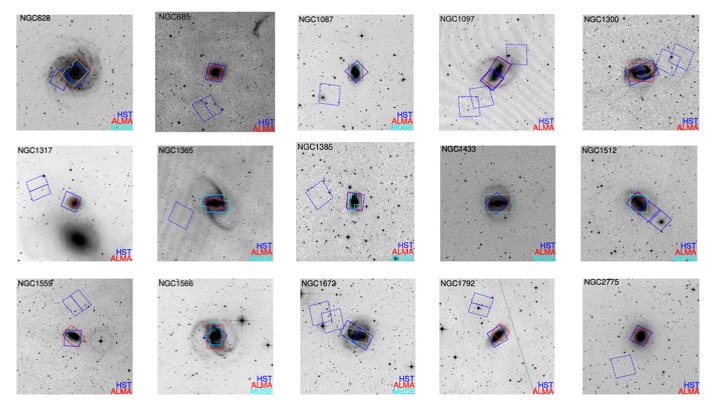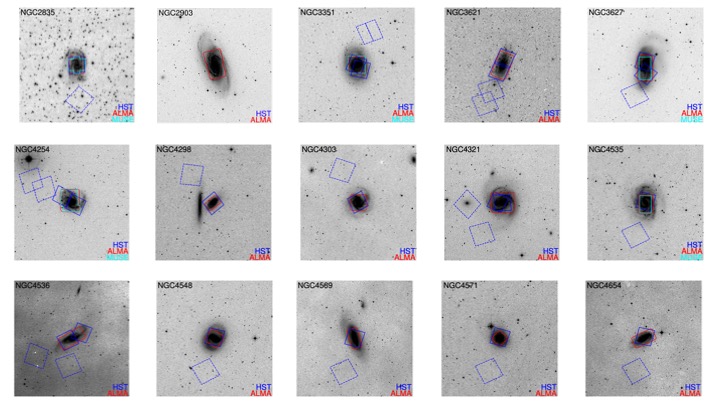Mission Overview
Physics at High Angular resolution in Nearby GalaxieS - HST Image Products ("PHANGS-HST")
Primary Investigator: Janice C. Lee
HLSP Authors: Leonardo Ubeda, Brad Whitmore, Dave Thilker, Janice C. Lee, Richard White, Gagandeep Anand, Stephen Hannon
Released: 2021-01-11
Updated: 2023-12-15
Primary Reference(s): Lee et al. 2022
Citations: See ADS Statistics
Source Data:
Overview
The PHANGS program is building a panchromatic dataset to enable the multi-phase, multi-scale study of star formation across nearby spiral galaxies. PHANGS combines Atacama Large Millimeter/submillimeter Array (ALMA) CO(2-1) mapping, Very Large Telescope/Multi Unit Spectroscopic Explorer (VLT/MUSE) optical spectroscopy, Hubble Space Telescope (HST) UV-optical imaging, and James Webb Space Telescope (JWST) infrared imaging among other supporting datasets. PHANGS is using these data to study the star formation cycle and various phases of the interstellar medium.
The PHANGS-HST Treasury survey obtained five band NUV-U-B-V-I imaging of the disks of 38 spiral galaxies (plus 1 companion dwarf galaxy) at distances of 4-23 Mpc, and parallel V and I band imaging of their halos. Here the team provides image products for the primary observations, as well as convolutional neural network models for image classification of star clusters and compact stellar associations.
DR4 - Catalog Release 2 (December 15, 2023)
Visit the PHANGS-CAT HLSP page for references and documentation. Links to the catalog files are also provided in the main PHANGS data access table.
Catalogs of the observed properties of star clusters and compact associations for the full sample of 38 PHANGS-HST spiral galaxies (plus 1 companion dwarf galaxy) are provided. The catalogs include photometry for a total of ~100,000 star clusters and associations (Maschmann, Lee, Thilker, Whitmore, et al. submitted).
Catalogs containing the physical properties based on SED fitting of the HST NUV-U-B-V-I photometry will be provided in an upcoming delivery.
Catalogs for multi-scale associations will be provided at some future date.
DR3 - Catalog Release 1 (February 08, 2022)
Visit the PHANGS-CAT HLSP page for references and documentation. Links to the catalog files are also provided in the main PHANGS data access table.
A set of catalogs for compact clusters (CC) and a separate set of catalogs for multi-scale associations for five galaxies (NGC 1433, NGC 1566, NGC 1559, NGC 3351, NGC 3627) are being released as part of DR3. These are described at different levels of detail in Lee et al. 2022, Whitmore et al. 2021, Thilker et al. 2022, and Larson et al. 2022 (in prep). Published papers using these datasets include Wei et al. 2020, Turner et al. 2021, Whitmore et al. 2021, Lee et al. 2022, Deger et al. 2022, and Thilker et al. 2022.
DR2 - Image Release 2 (August 09, 2021)
Completes the image product release for the full PHANGS-HST sample. It also provides convolutional neural network (CNN) models trained with deep transfer learning, for the classification of star clusters, and a sample Jupyter Python notebook that demonstrates how to use these models. NOTE: the notebook is delivered by the PHANGS-HST team, provided by MAST "as-is", MAST does not assume responsibility for the long-term maintenance of this notebook. Models with two different architectures, ResNet18 and VGG19-BN, along with the tutorial notebook, can be accessed in the Data Access section below.
DR1 - Image Release 1 (Jan. 11, 2021)
Provides the following image products for observations in the NUV-U-B-V-I bands for 29 out of 38 PHANGS-HST galaxies:
- FLC FITS file for each exposure with astrometric solutions updated based on GAIA DR2 sources.
- Combined DRC FITS images of individual pointings in each filter, each drizzled onto a common pixel grid defined for the galaxy target, also with astrometric solutions based on calibration to GAIA DR2 sources.
- Mosaicked DRC FITS images in each filter for 6 galaxies covered by multiple pointings (NGC 628, NGC 1300, NGC 1672, NGC 3351, NGC 3627, NGC 4321).
- ERR and EXP weight FITS images for individual pointings as well as mosaics.
PHANGS Data from JWST
15 December 2023: PHANGS-JWST processed images from Cycle 1 are now publicly available through https://archive.stsci.edu/hlsp/phangs/phangs-jwst
PHANGS Data From ALMA and MUSE
30 April 2021: Associated ALMA and MUSE data are now publicly available through the PHANGS CANFAR site or https://sites.google.com/view/phangs/home/data
Footprint Gallery
Below you can find a DSS image gallery of the PHANGS-HST galaxies with footprints from HST (blue), ALMA (red), and MUSE (cyan, available for 19/38 galaxies).
|
|
|
|
Data Products Description
The "_err_drc_wht.fits" images are inverse variance maps incorporating contributions from the detector and the Poisson noise from the astrophysical scene, modulated by the number of integrations ("flc" images) drizzling into an output pixel and the effective exposure depth after masking, respectively. The "_exp_drc_wht.fits" images contain the effective drizzled exposure time per pixel in units of seconds.
The drizzled science and weight files have the following naming convention:
hlsp_phangs-hst_hst_<ins>_<target>_<filter>_v1_<etype>-drc-<type>.fits
where:
- <ins> = Name of instrument, either "wfc3-uvis" or "wfc-acs".
- <target> = Name of galaxy, e.g., "ngc1566", if a mosaic, will include "mosaic" after the galaxy name, e.g., "ngc1300mosaic".
- <filter> = Name of filter used, e.g., "f275w".
- <etype> = Either "exp" or "err", depending on the type of map.
- <type> = Type of image, either "sci" for science or "wht" for weight.
The individual calibrated, flat-field images have the following naming convention:
hlsp_phangs-hst_hst_<ins>_<target>-<id>_<filter>_v1_flc.fits
where:
- <ins> = Name of instrument, either "wfc3-uvis" or "wfc-acs".
- <target> = Name of galaxy, e.g., "ngc1566", if a mosaic, will include "mosaic" after the galaxy name, e.g., "ngc1300mosaic".
- <id> = HST ID of the observation, e.g., icdm17kcq.
- <filter> = Name of filter used, e.g., "f275w".
A set of 10 convolutional neural network models for cluster classification are stored in .tar bundles with the following naming convention:
hlsp_phangs-hst_hst_model_<type>_multi_v1_bundle.tar
where:
- <type> = Type of convolutional neural network architecture, one of "resnet" for ResNet18 or "vgg" for VGG19-BN.
Data file types:
|
_exp-drc-sci.fits |
Drizzled science image. |
|
_exp-drc-wht.fits |
Exposure time maps. |
| _err-drc-wht.fits | Inverse variance maps. |
|
_flc.fits |
Individual calibrated, flat-fielded image. |
| _bundle.tar | Collection of CCN models of a given architecture. |
Data Access
For HST image products, please refer to the data table on the main page for data access.
Convolutional Neural Network Models And Tutorial For Cluster Classification
Note: The Jupyter Python notebook was made available as received from the PHANGS-HST team. MAST is not responsible for the long-term maintenance of this notebook tutorial.
| ResNet18 Architecture (~894 MB) | VGG19-BN Architecture (~11 GB) | Notebook Tutorial |
|---|---|---|
| hlsp_phangs-hst_hst_model_resnet_multi_v1_bundle.tar | hlsp_phangs-hst_hst_model_vgg_multi_v1_bundle.tar | hlsp_phangs-hst_hst_model_any_multi_v1_starcluster-classification.ipynb |









